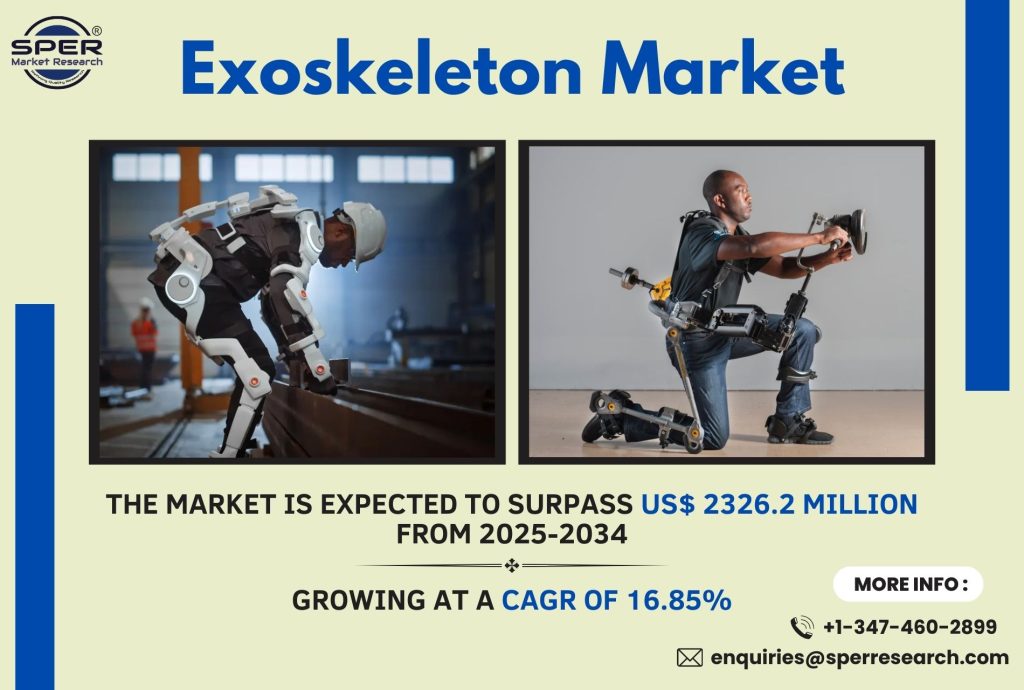Exoskeletons are robotic-assisted wearable devices that enhance human mobility, strength, and endurance by providing external support to the body. These systems are used in healthcare to assist individuals with paralysis or musculoskeletal disorders, enabling rehabilitation and improving quality of life. In industrial settings, exoskeletons help reduce physical strain on workers, preventing injuries and improving productivity. Military applications focus on enhancing soldier endurance and load-bearing capacity. With advancements in AI, battery technology, and lightweight materials, modern exoskeletons are becoming more efficient and adaptable. The increasing need for mobility solutions, workplace ergonomics, and injury prevention is driving the adoption of exoskeletons across multiple industries, making them a crucial innovation in assistive and wearable robotics.
According to SPER Market Research, ‘Global Exoskeleton Market Size – By Mobility, By Technology, By Extremity, By End Use – Regional Outlook, Competitive Strategies and Segment Forecast to 2034’ state that the Global Exoskeleton Market is predicted to reach 2326.2 million by 2034 with a CAGR of 16.85%.
Drivers:
The exoskeleton market is expanding due to the rising demand for rehabilitation devices for stroke and spinal cord injury patients, as well as the growing prevalence of age-related mobility impairments. Industrial workers benefit from exoskeletons that reduce fatigue and prevent musculoskeletal disorders, increasing their adoption in manufacturing, logistics, and construction. Military forces worldwide are investing in exoskeletons to improve soldier endurance and operational efficiency. Technological advancements, including AI-powered exosuits and soft robotics, are making exoskeletons lighter, more efficient, and more adaptable to user needs. Additionally, government support and funding for assistive robotic technologies, coupled with increasing research and development investments, are accelerating market growth globally.
Request a Free Sample Report: https://www.sperresearch.com/report-store/exoskeleton-market-future-outlook?sample=1
Restraints:
Exoskeletons have great potential, but a number of obstacles prevent their widespread use. Many people and organizations, especially in developing nations, cannot afford these devices due to their high manufacture and purchase prices. Long-term usage and user comfort are impacted by exoskeleton weight and battery restrictions. Long approval procedures and regulatory barriers prevent new items from entering the market quickly, which limits innovation. Adoption is also slowed by industries’ reluctance to spend money on costly robotic solutions. Furthermore, it’s still quite difficult to make sure exoskeletons are easy to use and can fit different body shapes. For the market to continue growing, these obstacles must be removed through affordable technologies, better battery technology, and streamlined regulations.
The Global Exoskeleton Market is dominated by North America due to its strong presence of robotics and healthcare technology companies, significant investments in research and development, and early adoption of assistive robotic technologies. The region benefits from favorable government initiatives supporting exoskeleton deployment in rehabilitation and defense sectors. Some of its key players are – ActiveLink, Cyberdyne Inc, Ekso Bionics, Hocoma, Lockheed Martin Corporation.
For More Information, refer to below link: –
Related Reports:
Follow Us –
LinkedIn | Instagram | Facebook | Twitter
Contact Us:
Sara Lopes, Business Consultant — USA
SPER Market Research
enquiries@sperresearch.com
+1–347–460–2899



